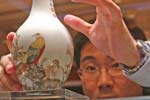Money
Government boosts the bond markets
Updated: 2011-04-09 10:15
By Wang Xiaotian (China Daily)
BEIJING - China will encourage businesses to raise funds by issuing bonds, and will gradually open up the bond and other financial markets to overseas investors, the People's Bank of China (PBOC) said in an annual report on its website on Friday.
"As China puts restructuring of the economic growth pattern at the top of its agenda during the next few years, we will encourage and support enterprises in some key industries, especially small- and medium-sized enterprises, to raise funds through all kinds of bonds," said the central bank.
|
 The headquarters of the People's Bank of China in Beijing. The country will gradually open the bond market to overseas investors, according to the central bank. [Photo/China Daily] |
In 2010, China's inter-bank spot bond trading reached 64 trillion yuan ($9.76 trillion), a rise of 35.5 percent over the previous year. That saw the country ranked in second place in Asia and sixth in the world by trading volume, according to the report.
Bond issuance rose from 8.93 trillion yuan in 2009 to 9.83 trillion yuan in 2010 (including central bank bills), an increase of 10.19 percent year-on-year. Corporate bonds accounted for 33.66 percent of the total issuance.
| ||||
The PBOC predicted that the range and number of enterprises that gain funds through the financial markets will further increase, while stock and bond issuance and trading volumes will also rise.
Lu Zhengwei, chief economist at Industrial Bank, said instead of an obvious rise in bond issuance and trading volumes this year, the proportion of bond financing to total financing and the proportion of corporate bonds among the total number of bonds issued will increase.
"The volume of bonds to GDP should move from the current figure of less than 10 percent to somewhere above 40 percent," said Lu.
He said the government's promotion of the bond market has been prompted by the increasing difficulties faced by companies in gaining funds through bank loans, but is also aimed at laying a path for yuan internationalization and a liberalization of interest rates.
"Under the 'prudent' monetary policy adopted in 2010, the demand for funds to develop emerging industries will turn to the capital markets," said the PBOC, adding that infrastructure projects whose construction began at the end of 2008 are creating a constant demand for credit.
China has adopted a tightening monetary stance to soak up excessive liquidity and curb inflation. The government didn't set a new-yuan lending target this year as it usually does, but analysts said the unofficial 2011 credit target is thought to be 7.5 trillion yuan including loans off balance sheet.
In 2010, new-yuan loans reached 7.95 trillion yuan, exceeding the government's target of 7.5 trillion excluding off-balance-sheet lending.
Lian Ping, chief economist at the Bank of Communications, said earlier that last year lending accounted for 75 percent of the nation's total financing, while fundraising through stocks and bonds each accounted for 12.5 percent.
In a report published on Jan 30, the central bank pledged to strengthen control over the total financing volume to keep inflation at a stable rate. "In recent years, the diversification trend in China's financial structure has burgeoned, and the proportion of direct financing has improved significantly," it said.
The bank is also gearing up to adopt an indicator measuring total financing volume and broader measures of money supply to better monitor liquidity conditions and to counter inflation.
The quantitative-easing policies adopted by major world economies such as the United States have led to increasing capital flows into emerging markets, a factor which is pushing up inflation, said analysts.
Major currency-issuing nations are likely to continue with low interest-rate policies, which will result in more capital inflows, and raise pressure on asset prices and yuan appreciation, according to the PBOC.
Specials

Share your China stories!
Foreign readers are invited to share your China stories.

Art auctions
China accounted for 33% of global fine art sales.

Waiting for drivers' seat
Lack of sponsorship appears to be why Chinese drivers have yet to race in a Formula 1 event



